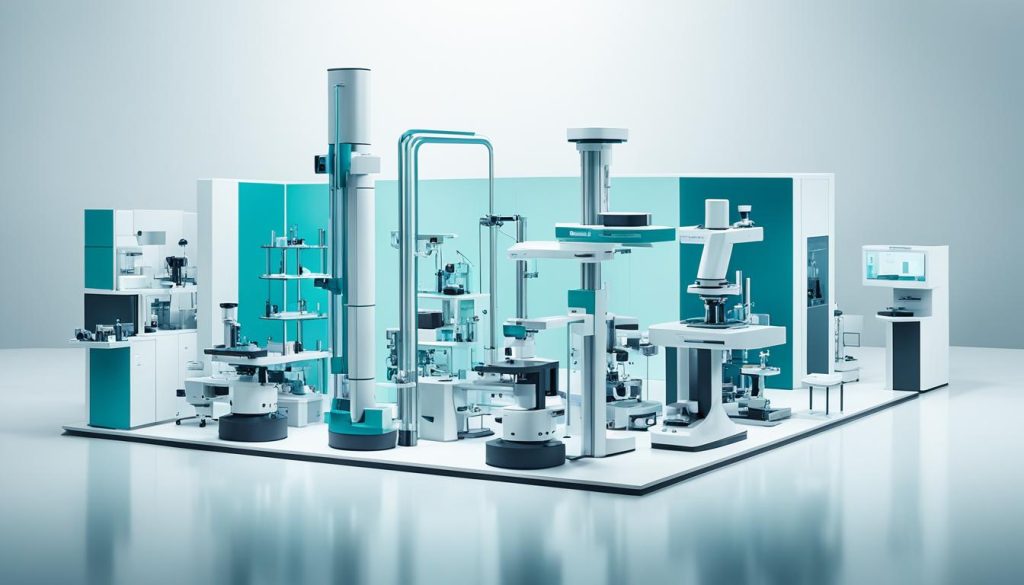Germany leads the way in business innovation by blending business and science. This creates new products and technologies. The country is a top player in this with about EUR 113 billion spent on research in 2021. This is 3.1 percent of its GDP. Germany is a shining example of turning research into innovation within the EU.
- The Role of Business and Science in Innovation
- R&D Spending in Germany
- Germany’s Status in European R&D
- Contribution of Business Enterprises to R&D
- The Largest R&D Community in Europe
- Renowned Research Institutes in Germany
- Publicly Subsidised Research Communities
- The Unique Structure of German R&D
- Germany’s Innovation Networks and Clusters
- The “Go-Cluster” Initiative
- Germany’s Global Competitiveness
- Driving Factors Behind German Innovation
- Weaknesses in Germany’s Innovation System
- Source Links
The country’s modern business sector is a big part of this success. It shows Germany’s strong desire to keep its position as a top global economy. Also, it highlights the excellence of German industries.
Key Takeaways
- Germany excels in business innovation, integrating business with science.
- R&D spending reached EUR 113 billion in 2021, 3.1% of GDP.
- Germany exemplifies innovation efficiency across the EU.
- The progressive business sector contributes significantly to these achievements.
- Commits to maintaining its role as a global economic leader and industrial exemplar.
The Role of Business and Science in Innovation
Germany leads in combining science with business. This joining has moved both fields forward. It has helped create new ideas and technologies.
Collaborative Efforts
In Germany, teamwork between science and business is key. Mixing academic knowledge with business skills has worked well. It has made a place where new technology can grow. These partnerships not only boost the economy but also help new business ideas succeed through working together.
Innovative Products and Technologies
Germany is known for its advanced products and technology. Matching research with what people need, Germany leads in tech. This shows how science and business working together can create change globally.
R&D Spending in Germany
Investing in Research and Development (R&D) is key for German businesses. It helps keep the country ahead in technology in Europe. By putting a lot of money into R&D, Germany has become a global leader in tech growth.
Current Investment Levels
Germany stands out in its dedication to research spending. They have allocated an impressive EUR 113 billion for R&D. This shows how serious they are about creating new things and staying at the top of the tech world.
This high funding also means Germany has a strong plan to keep investing in R&D. That’s a very important strategy for the country’s economic growth.
Historical Trends and Growth
In the last ten years, Germany has steadily put more money into R&D. This effort has led to a big increase in research funding. They have even gone over the EU’s suggested investment for five years straight.
This ongoing increase in R&D spending shows Germany’s deep commitment to tech progress. It helps them lead in innovation on a global scale.
Germany’s Status in European R&D
Germany plays a key role in European research and development. It outperforms many other EU nations. This is due to its strong focus on R&D.
Comparison with Other EU Countries
Compared to other EU countries, Germany does very well in R&D. It comes fourth behind Belgium, Sweden, and Austria. This shows how committed Germany is to its R&D efforts.
Achievements of the EU Three Percent Goal
Germany has met the EU target of spending three percent on R&D. This shows it plays a leading part in EU innovation. Business makes up most of this spending. It boosts Germany’s position in leading EU R&D.
Contribution of Business Enterprises to R&D

In Germany, private sector research is key to the nation’s R&D success. Companies invest a lot in R&D, making Germany a top global innovator.
German companies play a crucial role in innovation. They invest in new projects to create advanced technologies. This makes Germany well-known worldwide for its innovation.
Corporate R&D and private sector research work together to create new technologies. By investing in innovation, companies help in the continuous development of new solutions. This keeps them ahead in the global market.
The Largest R&D Community in Europe
Germany is at the heart of Europe’s biggest R&D community. It has 24 percent of the scientists and engineers on the continent. This expertise helps Germany lead in engineering research. It leads to innovations felt around the world. The German R&D community works closely with others around the world. It plays a big part in global technological progress.
Scientists and Engineers in Germany
German experts do crucial work in many areas, like cars and green energy. Germany’s strong education and research facilities attract the best minds. This keeps Germany ahead in engineering research. There’s a strong spirit of working together. This helps in making new, important discoveries regularly.
Global Research Cooperation
Germany’s R&D efforts rely heavily on working with others globally. They have partnerships with more than 120 countries. This allows for big projects that advance technology. These partnerships improve the R&D scene, sharing knowledge and skills. Germany becomes a key player in worldwide research. Working together means their discoveries reach further. It boosts innovation across the globe.
Renowned Research Institutes in Germany

Germany is home to several top research institutes. These are key players in driving global innovation. The Fraunhofer-Gesellschaft and Leibniz-Gemeinschaft particularly shine. They help businesses and make a huge impact.
Fraunhofer-Gesellschaft
The Fraunhofer-Gesellschaft is crucial for advancing technology in Germany. This group focuses on practical research. It creates a link between school studies and real-world needs.
Fraunhofer helps small and medium businesses get access to high-tech gear. This support speeds up the creation of new and amazing products.
Leibniz-Gemeinschaft
Leibniz-Gemeinschaft also does a lot for science and business. It mixes different areas of research to solve big problems. This helps small businesses grow and stay ahead in the worldwide market.
The teamwork between Leibniz and companies makes German research stronger. It has good effects on science and the economy in the long run.
Publicly Subsidised Research Communities
Germany is committed to pushing technology forward. It shows in its wide network of publicly subsidised research communities. These communities play a big part in sparking new ideas. They help out small and medium-sized businesses (SMEs) a lot. They give them the help and tools they need.
Benefits for SMEs
Joining these research groups has lots of pluses for SMEs. They get to use the latest research and development places. This can really help them grow and stay ahead. What’s more, getting money from public funds means they worry less about the cost. It lets them put more effort into coming up with new and exciting things.
Outsourcing Fundamental Research
Another big win for SMEs is being able to hand off risky research. They work with top research teams in the public sector. This way, they avoid the hard parts of testing new ideas. The result? New products show up faster. This mix of skills often leads to huge steps in technology.
The Unique Structure of German R&D

Germany’s way of handling Research and Development (R&D) is all about working together. It shows how important academic institutions and businesses working together are. This model boosts efficiency and new ideas in many fields.
Interaction Between Universities and Industry
In Germany, creating new knowledge is about teamwork between universities and businesses. Companies like Siemens and Bosch team up with schools. This partnership quickly turns new ideas into real products, pushing technology forward.
Division of Labour in Knowledge Creation
In Germany, R&D works in a special way. Universities dig deep with fundamental research, creating new scientific knowledge. Businesses and groups like Fraunhofer-Gesellschaft focus on using this knowledge to make real-world products. This teamwork makes the whole process work better.
Working closely together, universities and businesses create a strong system for new knowledge in Germany. This special way of dividing work helps create a place where innovation can really happen. It keeps Germany leading in new technology.
Germany’s Innovation Networks and Clusters
Germany is a key player in innovation thanks to its strong networks and clusters. These technology hubs help different groups work together. They ensure new tech meets what the market needs.
These networks don’t just exist in big cities. They reach out into smaller areas too. This creates a wide system of innovation across the country. It allows ideas and resources to move freely, from cars to bioengineering.
- Innovation networks link everyone together for better tech. They include businesses, schools, and research places.
- Regional clusters are in specific places. They bring together talented people and resources. This makes special industries grow and boosts the area’s economy.
- Places like Berlin, Munich, and Stuttgart show this well. They host many start-ups, big companies, and research places. They all work together on new ideas.
These clusters are very important for growing the economy. They help keep Germany ahead in tech worldwide. By working together and using resources well, Germany’s innovation spots keep pulling in new money and smart people from everywhere.
The “Go-Cluster” Initiative

The “Go-Cluster” initiative is a top programme led by the Federal Ministry of Economic Affairs and Climate Action. It aims to enhance the performance of clusters. These partnerships between industry and science promote strong innovation.
Criteria for Membership
To join the “Go-Cluster” initiative, clusters must meet certain high criteria. They must show they are innovative, work closely with both industries and science, and use advanced tech. Each group goes through a rigorous check to make sure they create an environment that supports growth and development.
Benefits of Membership
Being a part of the “Go-Cluster” brings many benefits. Clusters get more funding for special services, which helps them work better. It shows they are committed to being leaders in innovation and quality. Plus, the initiative encourages strong relationships between industry and science, promoting constant progress and the lasting success of its members.
Germany’s Global Competitiveness
Germany stands out in the global innovation ranking. It excels at turning new ideas into real achievements. This is especially true in the automotive and tech fields.
World Economic Forum’s Report
According to the World Economic Forum, Germany is known for innovation. Its strong infrastructure, skilled workers, and focus on Research and Development (R&D) help it lead globally. The report shows how Germany keeps innovating, always improving and adapting.
Germany’s Ranking in Europe
In Europe, Germany’s economy leads, especially in innovation. It’s a top spot for both big and new businesses. Germany is ahead thanks to its smart investments and use of high-tech.
Driving Factors Behind German Innovation
Germany leads in global innovation due to key factors that work together. They make advancements in new technology possible with a big focus on research and development (R&D). These efforts, along with a strong economy and high industrialisation, set the stage for tech breakthroughs.
Germany stands out in bringing new ideas to life. The country excels in converting innovations into products ready for the market. This fast process is essential for Germany’s economy to keep growing and stay dynamic.
The teamwork between universities, research centres, and industries also boosts innovation. This collaboration helps speed up tech development. It creates an atmosphere that encourages constant enhancements and new innovations.
In conclusion, Germany’s strategy mixing investment, economic strength, and advanced tech processes puts the country ahead in innovation worldwide.
Weaknesses in Germany’s Innovation System
Germany is known across the world for its strong innovation scene. Yet, it faces challenges that need work. One big issue is the country’s telecommunication system. This problem affects how efficient and productive things are.
Telecommunication Infrastructure
One main problem for innovation in Germany is its telecommunication system. The upgrade of this network is not happening fast enough. This slow progress stops the smooth use of new tech in various fields. Germany needs to tackle this challenge quickly to keep its lead.
Broadband Expansion Initiatives
Germany is fighting these issues with a big plan to expand broadband. This effort aims to erase the digital gap within the nation. Not only do these plans improve the IT setup, but they also help keep Germany’s innovation moving forward. Making fast internet available in towns and the countryside is key. It will help make the economy more in tune and flexible.
Source Links
- https://www.gtai.de/en/invest/business-location-germany/innovation-in-germany
- https://www.deutschland.de/en/topic/business/why-is-germany-the-worlds-most-innovative-country
- https://www.oecd-ilibrary.org/benchmarking-german-innovation-performance_71a05df5-en.pdf?itemId=/content/component/71a05df5-en&mimeType=pdf











